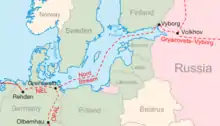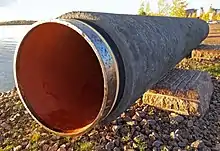Nord Stream
Nord Stream (German–English mixed expression for "North Stream"; Russian: Северный поток, Severny potok) is a network of offshore natural gas pipelines which run under the Baltic Sea from Russia to Germany to provide Western Europe with natural gas. It comprises two separate projects, Nord Stream 1 and Nord Stream 2. Both pipelines each comprise two pipes, NS1 A and B as well as NS2 A and B, for a total of 4 physical pipes. Both pipelines start in Russia and land in Lubmin, Germany. They are majority owned (51 per cent) by Russia, along with German, Dutch and French stakeholders. They were financed by a consortium of companies from Russia, Germany, France, Austria and the Netherlands. It was the first pipeline that bypassed Ukraine and Poland to deliver Russian natural gas directly to West Europe.

The project Nord Stream 2 was opposed from the start by the United States,[1][2] who later imposed sanctions on companies that were involved in the project.[3] The U.S. sanctions were criticized heavily by German politicians as "a serious interference in the internal affairs of Germany and Europe and their sovereignty".[4]
- Nord Stream 1 (NS1) runs from Vyborg, in northwestern Russia near Finland, and entered service in 2011.[5] It is operated by Nord Stream AG. From 31 August 2022, Gazprom halted delivery indefinitely, officially because of maintenance.[6][7]
- Nord Stream 2 (NS2) runs from Ust-Luga in northwestern Russia near Estonia. The pipeline was built to increase gas exports towards Europe, aiming to double annual capacity. The project was completed in 2021, but did not enter service, because Germany withheld opening permission on February 22, 2022 due to Russia recognizing the Ukrainian separatist regions of the Donetsk People's Republic and the Luhansk People's Republic as independent,[8] in line with a previous joint warning made with US president Joe Biden on February 7, 2022 to end the project if Russia were to invade Ukraine.[9]
2022 sabotage
On 26 September 2022, news broke of four explosions at the Nord Stream 1 and 2 natural gas pipelines, rendering three of the four lines inoperable.
Although none of the four Nord Stream pipelines were in operation they still contained pressurized natural gas of which vast quantities were released into the Baltic Sea.
See also
References
- Stephen Kinzer: When pipeline politics go boom, Quincy Institute for Responsible Statecraft, 28 October 2022
- Attacke gegen Ex-Kanzler – US-Abgeordneter wirft Schröder „politische Prostitution“ vor., Süddeutsche Zeitung, 12 June 2007.
- U.S. imposes further sanctions in connection with Nord Stream 2 gas pipeline
- Germany "firmly rejects" U.S. sanctions on Nord Stream 2 firms
- "Controversial Project Launched : Merkel and Medvedev Open Baltic Gas Pipeline". Der Spiegel. 2011-11-08. ISSN 2195-1349. Retrieved 2022-10-13.
- Cooban, Anna (31 August 2022). "Russia cuts more gas supplies to Europe as inflation hits another record". CNN.
- "Gazprom: Nord Stream 1 gas to stay shut until fault fixed, "workshop conditions needed"". Reuters. 2022-09-02.
- "Germany freezes Nord Stream 2 gas project as Ukraine crisis deepens". 2022-02-22. Retrieved 2023-03-08.
- "Biden vows to end German-Russian gas pipeline if Ukraine is invaded". 2022-02-07. Retrieved 2023-03-08.
